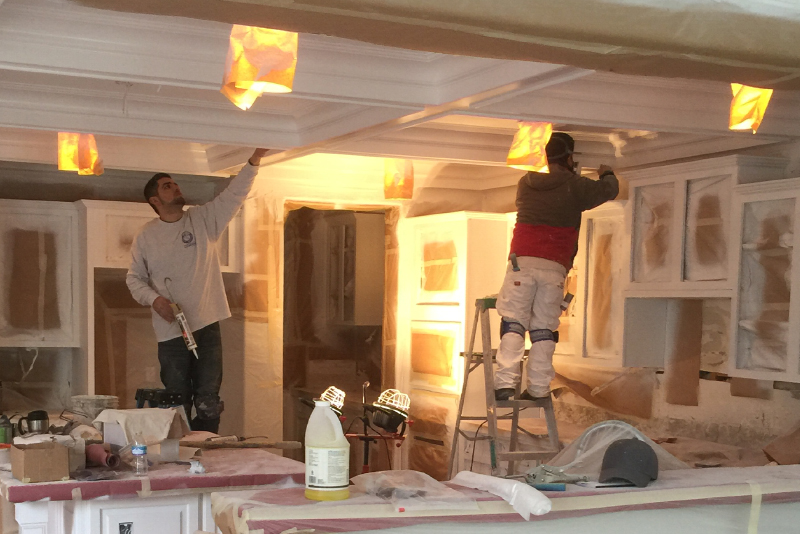Ceiling Painting Dos and Don’ts
There’s more to painting a room than adding color to the walls. Ceiling painting is a must if you want a cohesive appearance from a newly painted room.
Done with expertise, a well-painted ceiling can add polish and sophistication to any space. But there are some common pitfalls to avoid when planning and completing a ceiling painting project.
Here's what the professional house painters at TRICO PAINTING recommend doing (and not doing) when painting interior ceilings.
Do: Use the Right Tools and Materials
Before you start painting, get all your paints, primers, and painting materials together. Be sure you have enough paint and primer to completely cover the surface, and to get the finish you want, without over-applying. You'll want to have brushes on hand for smaller and more detailed areas. And choosing a roller is important, too. Different rollers have different textures, so you want to choose a paint roller that will give you the texture and finish you're looking for.
Do: Choose a Color That Suits Your Space
Ceiling paint colors can make or break the aesthetic of an entire room. Here are some guidelines to follow to feel more confident about ceiling paint color selection:
- Matching the Walls: Painting ceilings and walls the same color is always a safe bet. However, design experts like Custom Home Group recommend using half strength for ceilings: "If you do end up choosing the same color as the walls for the ceiling, go with half-strength for the ceiling. Since ceilings tend to look darker than the walls because of their placement, going half-strength on the color will offer a slight contrast. This also ensures it doesn’t end up being too dark in comparison to the walls. This rule usually does not apply with dark colors or very pale colors."
- Go Light, White, or Neutral: If you do change the color, we recommend lighter shades. They are more reflective and give the room a more open feeling. Whites and light neutrals do this well.
- Use a Color Wheel or Palette: Rather than choosing on a whim, or by what you think will look good, we suggest using a color palette or color wheel, so you can be certain to use truly complementary colors that won't clash.
Don't: Forget Safety
Ceiling painting has safety risks, as does any painting or home improvement project. Any time your work requires a ladder, additional attention to safety is necessary. Be sure your ladder is sturdy, and that you, or whoever is painting the ceiling is comfortable working on a ladder.
Extension poles are a convenient way to paint hard-to-reach areas on a ceiling without reaching or stretching to paint them in a way that feels uncomfortable or unsafe. You'll also want safety glasses or goggles to protect your eyes from paint particles or drips.
Do: Consider Popcorn Ceiling Removal
Textured, "popcorn" ceilings are not only notorious for being hard to clean and paint, they date a room immediately. If you're repainting ceilings to match a more modern, updated room, popcorn ceiling removal is a solid first step.
The resulting ceiling will be cleaner, smoother, and more likely to render a seamless paint finish. Some popcorn coatings are harder to remove than others, and some might contain traces of asbestos depending on their age, With these risks, we recommend hiring a local painting contractor who can remove popcorn ceilings safely and completely, without damaging the surface itself.
Do: Prepare and Repair
As tempting as it is to get done with a project sooner, simply painting over ceilings won't do. You'll have problems with your paint finish, and have to repaint ceilings much sooner than you planned, unless the surface is properly prepped and repaired. That includes:
- Removing all old and damaged paint
- Sanding and smoothing the surface
- Patching and repairing drywall of any holes or imperfections
Level, clean, and free of paint and debris: that's how you want your ceiling to look before you begin painting it.
Do: Remove Hangings and Fixtures
Remove anything hanging from or attached to your ceiling before you start painting. Take down any light fixtures, remove light bulbs, and cover anything electrical. You don't want errant paint to damage lighting features or electrical systems in your home.
Don't: Drip
Of course, you can't avoid 100% of paint drips. But there are a few things you can do to minimize their impact on your finished product.
- Remove everything you can from the room before you start painting
- Cover all surfaces you don't plan to paint with drop cloths and other protective coverings
- Don't overload brushes and rollers with primer or paint
- Paint using fluid motions and complete strokes
- Clean brushes properly when you're done using them
Do: Allow Time for Drying
One of the biggest issues DIY ceiling painting projects have is that the finish doesn't look how you envisioned. Sometimes it's too dark, or discolored in places, and sometimes it's not smooth. All of these problems can be avoided by allowing primers and paint coats to dry before applying more. How long you allow for drying depends on the type of surface, the size of the area you painted, and what products you used.
Don't: Let DIY Ceiling Painting Overwhelm You
If all of this seems overwhelming, don't let it stop you from getting the beautifully painted ceilings your rooms need to look their best.
TRICO PAINTING offers wall and ceiling painting services to homeowners and HOAs as part of our comprehensive interior painting services. We never skip a step or cut a corner when painting ceilings, removing popcorn ceilings, or painting the surrounding moldings and trim. Get ceiling painting done without having to worry about the stress or the mess. Get an interior painting estimate from TRICO PAINTING today!

